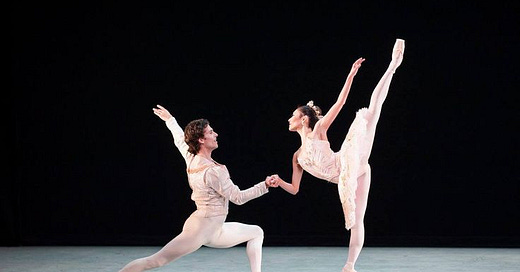Is a Martini better shaken or stirred?
The answer just might be Neither.
That’s the lesson I learned when I ordered a house Martini at Makoto, a small spot in the Northwest corner of the District of Columbia that was long the best, and most formal Japanese restaurant in Washington. It was shuttered for a couple years (one of the umpteen victims of Covid) but reopened last year. Now focused on Wagyu beef, it is better than ever.
No small part of the restaurant’s recaptured success can be attributed to bar manager Corey Landolt. He isn’t the most likely mixer of drinks. For some 15 years he was a featured dancer with the Washington Ballet, which is a good run given the notoriously short careers of dancers. All the while he was learning a trade for his post-ballet life. “If I wasn't performing on a weekend, I was bartending,” he says.
The headline on a New Jersey Stage review of Landolt dancing works choreographed by Balanchine was “Passion & Discipline.” Those are qualities that also inform his work behind the mahogany, where he practices precision. Almost comically so.
I found out just how precise when I went to Makoto and tried, not without a little skepticism, what was billed as a Japanese variation on the Martini. The drink begins with an excellent Japanese gin – Roku, made by Suntory using a half-dozen botanicals found in Japan, including sakura flower and yuzu peel. And then, instead of vermouth, the Makoto bar combines the gin with a Japanese sochu distilled from barley (a brand called Mugi Hokka – if you can’t find it, try Fuyu sochu).
But is the technique that matters here. Whether one is making a traditional Martini or the Japanese variation found at Makoto: the key to success is making the drink impossibly cold without watering it down.
Whether one shakes or stirs, the effort to make a Martini sufficiently cold tends to over-dilute the drink . That means, strictly speaking, there aren’t just two main ingredients in the drink, but three: First and foremost, gin; second, dry vermouth (of which there can be a little or a lot, to taste); third, the meltwater that comes from the ice in one’s beaker or shaker.
Some strive to make Martinis as cold as possible, and at the same time utterly undiluted, by keeping their gin in the freezer and their vermouth in the fridge. But that’s a mistake. Water is not something to be avoided in a Martini, it is a subtle part of the finished drink, smoothing out what might otherwise be a harsh blast of hard liquor.
Martini exactitude has long been pursued by obsessives. It is the Great White Whale in an ocean of drinks. Just ask Bernard DeVoto, A Pulitzer Prize-winning mid-century historian, speechwriter for Adlai Stevenson, Harper’s Magazine columnist, anti Anti-Communist, and Martini devotee, DeVoto was enough of a stickler that one could joke he demanded that his Martinis be composed and contrived — composed, really — of neither more nor less that 1.845206 ounces of gin to ½ an ounce of vermouth.
Even if one had the laboratory instruments necessary to measure out DeVoto’s preferred quantity, what about the water? DeVoto didn’t specify how much was preferable (or likely from his point of view, tolerable).
Water. Is it the Martini’s friend or enemy. What’s the right amount? How do you achieve it? These are questions that still bedevil. Partly because getting a properly Arctic Martini entails making trade-offs. Sure, the more one stirs or shakes, the colder the drink gets -- but the more diluted it gets too.
Which is where Landolt and his dancer’s precision comes into play. He worked his way through a score of dilution proportions to develop his Makoto Martini. He found the drink with 22 percent water added to the gin and sochu was better than the drink with 21 or 23 percent. In practice that would mean combining two 750 ml bottles of gin with one 700 ml bottle of sochu. Calculate 22 percent of that 2.2 liter total and add exactly that much filtered water -- 484 milliliters. Stir briefly and put it in the freezer for at least six hours.
The drink is ready straight from the icebox. Well, almost. Landolt pours the mix into a chilled cocktail glass and adds exactly three drops of Japanese cocktail bitters (a task made easy as the bitters bottle comes with an eye-dropper).
Lastly, before serving, Landolt clips to the rim of the glass a sprig of edible shiso flower. Gin and vermouth die-hards (among whom I count myself) will be happy to hear that Landolt’s procedure works just as well with the Martini’s traditional garnish. Make a gin-and-vermouth Martini with Landholts’s methodology. Just be sure to toss the frou-frou flower business and stick to an olive or three.
A version of this essay first appeared in the Washington Examiner



